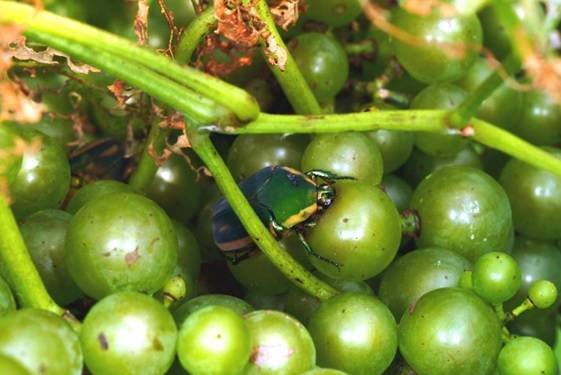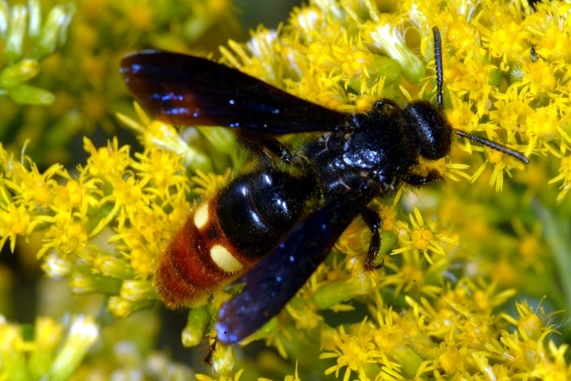Green June Beetle on Grapes
ENTFACT-227: Green June Beetle on Grapes | Download PDF
by Ric Bessin, Extension Speciliast
University of Kentucky College of Agriculture
Green June beetle is a serious direct pest of grapes at harvest, attacking the berries in the ripening clusters. Green June beetle is attracted to the ripening clusters as the berries soften and the sugar content increases. This creates a serious problem for grape growers, as they often don't realize the magnitude of the situation until harvest when their options are limited. Fortunately, this is not a problem every year as their populations fluctuate from year to year, in some years causing little damage but in other years causing substantial losses. Nor are all grape varieties are equally attacked, as those reaching maturity during the peak of the green June beetle flight are most vulnerable.

Figure 1. Green June beetle attacking grapes.
The green June beetle is a Scarab beetles and is commonly referred to as a "June beetle" or "Junebug." The adult is 3/4 inch to 1 inch long, and 1/2 inch wide with a dull green and tan back, with or without lengthwise tan stripes on the wings. The underside is iridescent bright greenish gold. The larval stage is found in the soil or crawling on the soil in the fall and winter. Larvae feed on decaying organic matter in the root zone of many grasses, as well as on the underground parts of plants. The larvae have the habit of crawling on their backs, holding their legs in the air. There are three larval stages, and are generally similar to other white gurb species. They reach 2 inches in length when mature, and are cream colored with tan head capsules and legs. The larvae pass the winter deep in the soil. In the spring, they tunnel near the surface where feeding takes place and pupate the following late spring or early summer. Mature larvae form hollow spaces in the soil and pupate there. They pupate in June and the adults emerge in July and August. There is one generation each year.
Management
Many grape growers would like to have an insecticide that could control these green June beetle and Japanese beetle at harvest, but spraying at harvest is difficult. First, the products that are effect against these pests have required pre-harvest intervals (REI's) that prohibit their use in the final few days before harvest. The more effective products for green June beetle control are those that have longer pre-harvest intervals, those with shorter pre-harvest intervals are generally less effective. In addition, during the pre-harvest period when the more effective products can be applied (ie. there is enough time to satisfy the pre-harvest interval requirement), green June beetle is not attacking the fruit. Be careful not to harm insect pollinators when using insecticides to control green June beetle.
Green June beetles can be managed on grapes in urban areas through the use of netting or row covers. Select netting with hole size sufficiently small to exclude the adults.

Figure 2. Green June beetles travel by crawling on their backs.

Figure 3. Scolia dubia is a naturally occuring wasp that parasitizes green June beetle grubs.
Scolia dubia
There is a naturally occurring wasp, Scolia dubia, that digs through the soil to lay eggs on green June beetle grubs. The wasp larvae feed on and eventually kill the grubs. Along with other natural enemies, the wasp helps to reduce green June beetle adult emergence.
Revised: 11/19
CAUTION! Pesticide recommendations in this publication are registered for use in Kentucky, USA ONLY! The use of some products may not be legal in your state or country. Please check with your local county agent or regulatory official before using any pesticide mentioned in this publication.
Of course, ALWAYS READ AND FOLLOW LABEL DIRECTIONS FOR SAFE USE OF ANY PESTICIDE!
Photos courtesy Ric Bessin, University of Kentucky Entomology
